The 1958 Gibson Flying V: A History (Part One)
How one of Gibson's most iconic instrument came about
1958 was the year that Gibson wanted to take on Fender at his own game. With his modern-looking Stratocaster solid-body electric guitar, Leo was making Gibson’s designs look old and boring. Gibson president Ted McCarty decided to hit back. The result was the very first Flying V!
Innovation in ‘58
You could say 1958 was a huge year of innovation for Gibson. It was the first year of the fabled Sunburst Les Paul model, the new semi-hollow/semi-solid ES-335 guitar model, and the Les Paul Jr and Special models had new double-cutaway versions. The company was facing stiff competition from California-based Fender, and it needed something special to take on Leo’s new-fangled guitar designs.
Ted McCarty
Back in 1944, the Chicago Musical Instrument company bought a controlling interest in Gibson. While the manufacturing remained in Kalamazoo, the new sales and administration headquarters had now moved to Chicago.
Theodore ‘Ted’ McCarty joined Gibson in 1948, and was initially hired as general manager, though he was soon promoted to company president in 1950. So Ted was already president of the largest instrument manufacturing company in the United States when Leo Fender debuted his first odd-looking solid-body “Spanish-style” Broadcaster (then Nocaster) as well as the Telecaster and Esquire guitar models.
In 1950, Leo’s solid-bodied electric guitar, which Gibson had initially dismissed, was becoming serious competition. Gibson needed to do something radical to reassert itself as the industry leader. This resulted in the company releasing the Les Paul model in 1952, its answer to Leo’s design.
To the Moon
By 1954, Leo Fender had introduced the futuristic-looking Stratocaster, which drastically moved away from the traditional guitar shape with its more asymmetrical body and deep cutaways. The design reflected the auto industry of the time, with its tail-fin flash. It perfectly captured the mood of ’50s America. Fender had even capitalised on the space-age trend with the guitar’s name.
Orville Gibson’s very traditional company, on the other hand, was looking very old hat, with its conventional instrument designs. The company was known for making, amongst other things, mandolins, banjos and traditional f-hole acoustic guitars, all of which had been popular back in the late 1920s and throughout the 1930s. The war years had placed constraints on what the company could use and, during the ‘40s, Gibson had become known for making banjos using a variety of leftover metal parts. These models are now often referred to as floor sweep models. By the ‘50s, the company’s designs were starting to look very dated and quite fuddy-duddy. The space race was on and the zeitgeist was aimed squarely at the future, and post-war America wanted modern designs.
Ted McCarty really admired Leo Fender, but he also wanted to take him on his own game, and so decided to jump in the ring with Fender. In the spring of 1957, McCarty’s team at Gibson came up with a plan to introduce three new ‘Modernistic’ models to take on Fender, and prove that Gibson was still innovating. Summer NAMM was fast approaching and McCarty wanted to make guitars that would turn heads and cause a stir at the popular trade show. The three proposed models would become famous as the Flying V, the Explorer and the Moderne.
The Flying V Team
Nobody is 100% certain how many people were actually responsible for the Flying V’s design. Though years later, during various interviews, McCarty has stated that there were three or four others, apart from himself, on the project. Ted’s main role would appear to have been motivation and inspiration for the team as a whole. He would bring ideas and push the team forwards. The team almost certainly included Jon House, who was McCarty’s right hand and in charge of production. Along with Larry Allers, the company’s Chief Woodworking Engineer, and Rendall ‘Ren’ Wall, one of the guitar players in the final assembly area.
Seth Lover, the designer of Gibson’s original PAF humbucking pickup, has also been quoted as saying he helped design the V body shape. Alhough Ted McCarty later recalls that Seth instead helped name the guitar. According to McCarty, when Seth first saw one he laughed and said, “well, that looks like a Flying V”. So that’s what they called it in June of 1957.
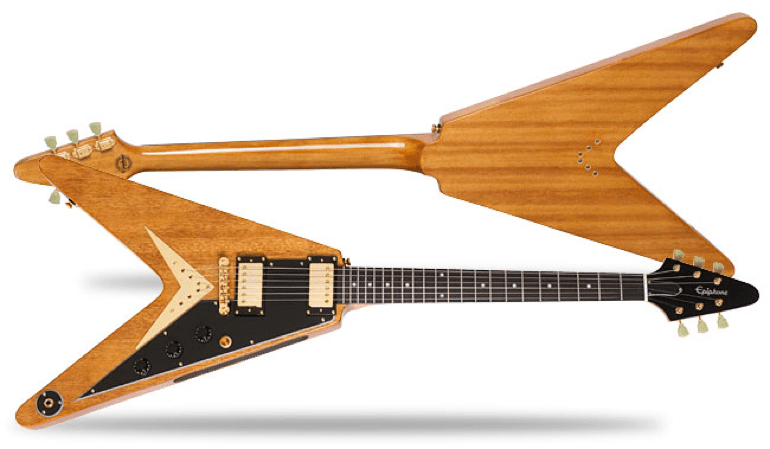
A modern 2016 Epiphone Korina Flying V, a homage to the original 1958 design · Source: http://www.epiphone.com/News/Features/Features/2016/Limited-Edition-Korina-Instruments.aspx
Patents
Gibson filed three patent applications for the new designs. These were ornamental design patterns and simple illustrations of each guitar. They showed a front and side image of each model, an unusual thing for Gibson, as it commonly filed invention patents for unique mechanical or electrical inventions, like its humbucking PAF (Patent Applied For) pickup.
This may have been in reaction to Leo Fender, who filed design patents for the Telecaster and Precision Bass models. McCarty could have been worried that Fender might try to put out his own versions of these three new Gibson body shapes.
The new shapes were unveiled at the Summer 57 NAMM show in Chicago. A rough early version of the Futura, which would later be named Explorer was shown. There’s just one photo of this Explorer-style unfinished prototype in existence. And, it’s not really clear if either the Flying V or Moderne were actually there at the 57 NAMM Show.
It’s likely a Flying V prototype was, in fact, there, as it would help McCarty get feedback from the dealers visiting the Gibson booth. This dealer reaction often dictated if a guitar was put into production, and we can guess that the Flying V and the Explorer did fairly well. But the response to the poor old Moderne was not quite so positive, and the model was shelved.
According to a daybook listing from the Gibson factory in Kalamazoo, the Flying V began production on February 21, 1958. The book lists some other instruments in production at the time that include an ES 355T, EB-2, and LP Cherry Red. But at the very top of the handwritten list is a Flying V in Korina.
1958 Prices
March 1958 saw Gibson release its new product catalogue for the year. In it was a half-page showing the new Flying V model. The guitar listed for $247.50, with an additional $75 for the custom hard case. It cost the same as a Les Paul Gold Top model.
By comparison, the Fender Stratocaster was being listed for $274.50 and the Telecaster was $199.50.
Why Korina?
Dealers began receiving guitars later that month. The most obvious feature of the production guitar, besides its striking shape, was the use of Korina instead of mahogany. When asked why Korina was used, McCarty said that blonde finish guitars were popular at the time and that by using Korina they could achieve that desirable lighter finish.
It was also a popular look in the mid-century modern furniture of the 50s. And, of course, Fender’s Telecaster and Esquire already had a blonde finish as standard. At the 57 NAMM show, Fender had also displayed a Stratocaster in blonde with gold hardware.
Korina is the US trade name for a West African hardwood usually known as Limba. It is often compared to mahogany in terms of its average weight, tonal characteristics and how it works in guitar building. Gibson also used Korina for its Skylark lap steel guitars in 1957, so it’s likely that there was already plenty of stock wood in the factory.
The Original V Design
The new Flying V design had two legs making up its V-body shape. The ends and corners were soft and rounded. The square shoulders curved in where the neck joined the body. The front of the body was routed, to hold the pickups and controls, and was covered by the pickguard. A narrow strip of ridged black rubber was glued to the lower edge of the body. This was actually a bit of floor mat glued there in the hope of keeping the guitar from slipping when playing it sitting down.
Specifications
The guitar had a one-piece Korina neck and followed the standard Gibson formula of a glued-in tight mortise and tenon joint but, unusually for the V, the body wood overlaps the neck heel at the back. It had 22 frets on a Brazillian rosewood fingerboard, glued to the face of the neck over a channel that held the metal truss rod. The truss rod adjustment was at the headstock and there were small Pearloid plastic dot fret markers, with corresponding small dots on the side of the neck.
A white plastic nut was fitted to the typical Gibson 24.75″ scale-length neck. Headstock was a three-piece construction with a centre section and two glued-on sides. It was a triangular design with three-a-side Kluson tuners, and featured a silver-coloured plastic Gibson logo, the same one used on some of the company’s amplifiers. The serial number was stamped on the back of the headstock under clear lacquer. The first digit, either an 8 or a 9, indicates the year of production (1958 or 1959).
The pickguard was made of triple-layer white/black/white plastic and was attached with eight screws. One of the metal strap buttons was screwed to the inside of the upper leg, and the other to the upper body shoulder.
Hardware and electronics
The bridge was a gold-plated zinc alloy Tune-O-Matic ABR-1 model with six brass saddles and two gold-plated zinc adjustment wheels. The wing-shaped tailpiece of gold-plated brass was designed specifically for the model and is referred to as the Cadillac tailpiece, due of its similarity to the car company logo. It was fixed to the body with three small upholstery nails. The strings passed through the body, through the wing-shaped tailpiece and up over the bridge.
The now hallowed PAF humbucking pickups were set in black plastic mounting rings, attached to the body with four screws. These were wired via two volumes and a master tone control, along with a three-way selector switch. The plastic knobs are now referred to as top-hat knobs. The output jack was on the end of the lower leg mounted in a ring of white plastic.
Optional hard case
The hard case cost extra, and was custom-built for the Flying V by Geeb. It was a long triangular shape with a flat tip, and covered in the classic brown usually reserved for higher-end Gibson guitars. Inside was either a red or pink plush lining. The 1958 NAMM show included two Flying V models, though Explorers were beginning to be produced around this time.
Missing Evidence
The original daybooks have a gap right at this moment in the company’s history. It seems that the daybooks that contain everything from June 30th 1958 through to the 1960s have been lost. The book that could have told us so much about the history of the Modernistic guitar production, just isn’t available.
Fortunately, the end of the year tally sheets created by the managers are still in existence. These lists show a total of 81 Flying V guitars being produced in 1958. This is a very small number compared to the 434 Sunburst Les Paul models shipped that same year.
The Death and Re-birth of the Flying V
The final year entry for 1959 listed just 17 Flying V models. The Modernistic guitars were a failure by any measure and production eventually ceased in 1959. It would be a while before Gibson reintroduced the Flying V and Explorer to its catalogue.
In part two I will take you through the re-birth of the Flying V in the late 1960s and why Gibson decided to re-issue the model after its dramatic failure.
History of the Gibson Flying V Video
You are currently viewing a placeholder content from YouTube. To access the actual content, click the button below. Please note that doing so will share data with third-party providers.
You are currently viewing a placeholder content from YouTube. To access the actual content, click the button below. Please note that doing so will share data with third-party providers.
2 responses to “The 1958 Gibson Flying V: A History (Part One)”

 4,9 / 5,0 |
4,9 / 5,0 | 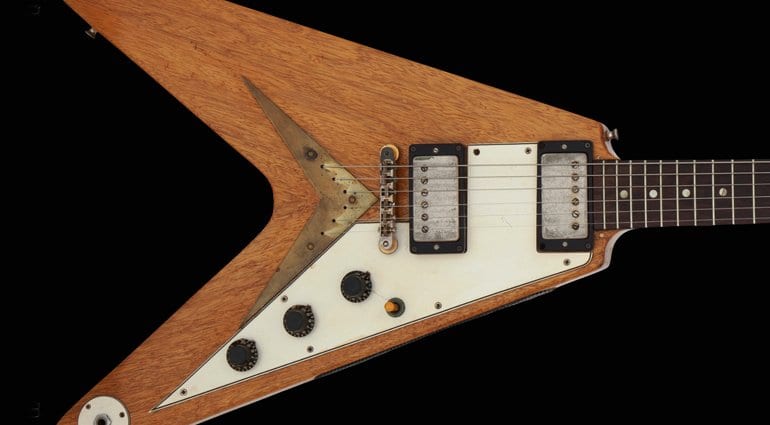

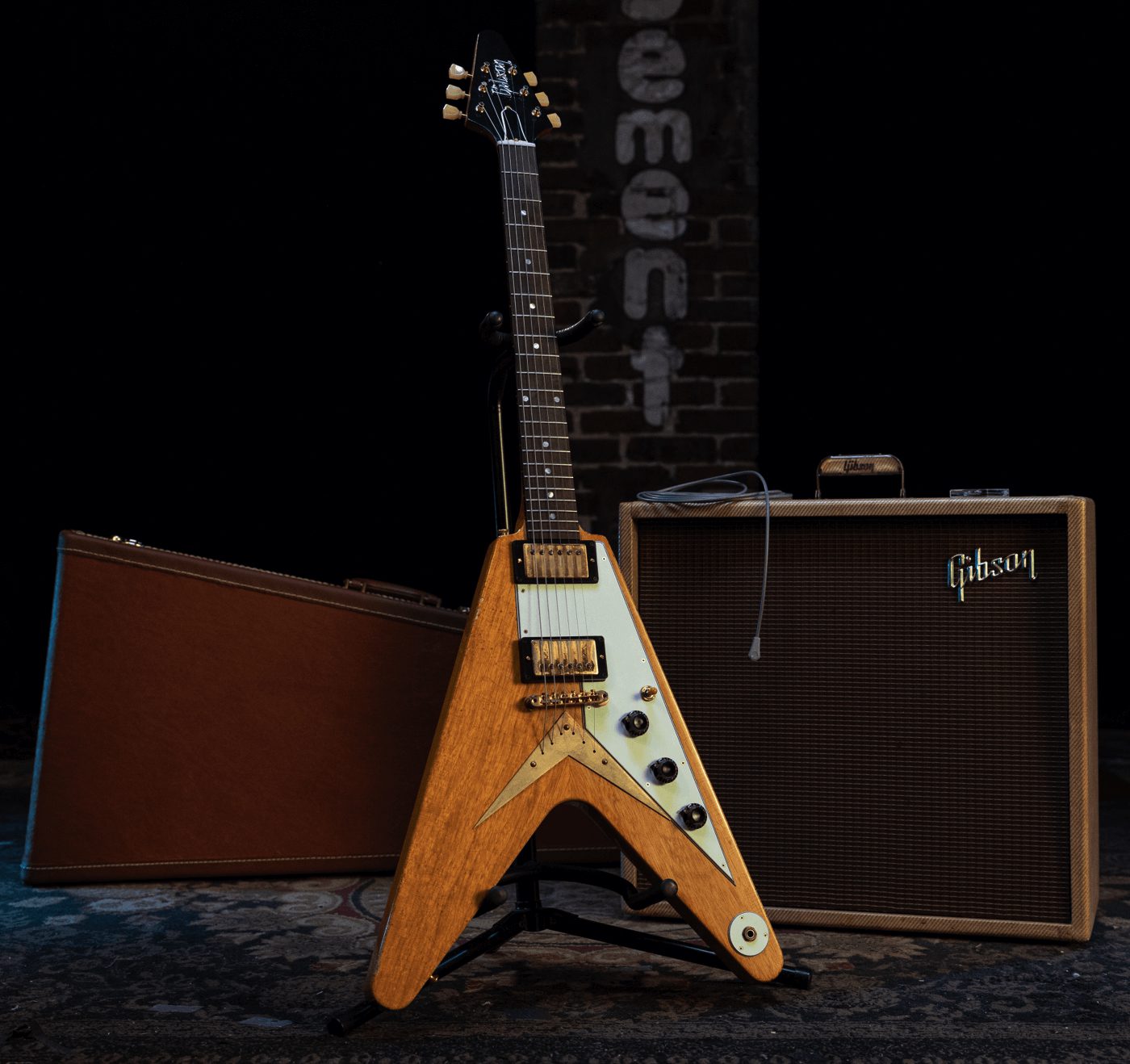
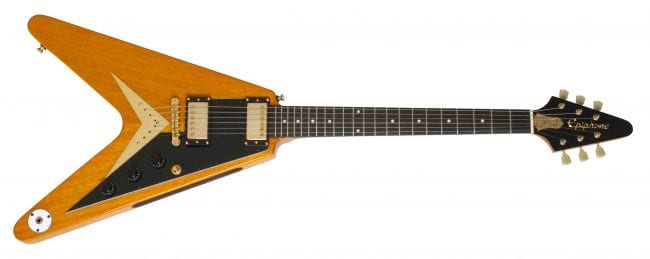
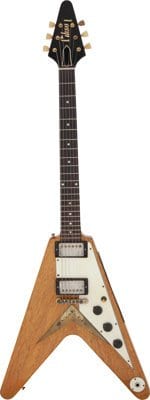
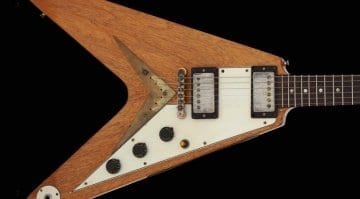

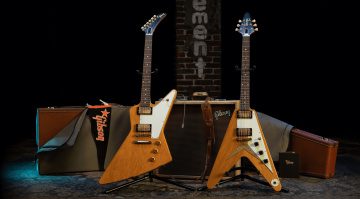
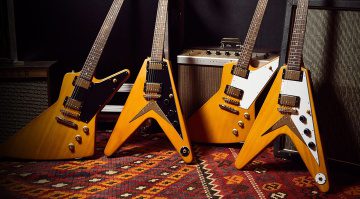
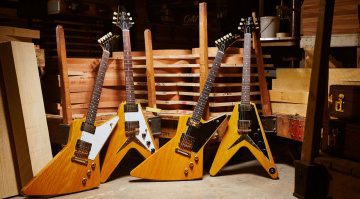
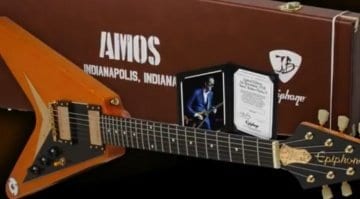

The video was very informative the Karina Flying V is my favorite guitar and I’m happy to read this I now own a Epiphone Karina playing me I used to have a Heritage back in 1983 with time serves me right I’ll get another Gibson one day thank you
I had an epiphone kprina explorer with black pick guard it played so nice and neck was so smooth.I replaced pick ups with bill Lawrence pick ups the guitar played and sounded like a dream on my Randall rg100es half stack I loved that guitar. My junkie brother stole my guitar for drugs hopefully one day I will buy another great guitar great sound .